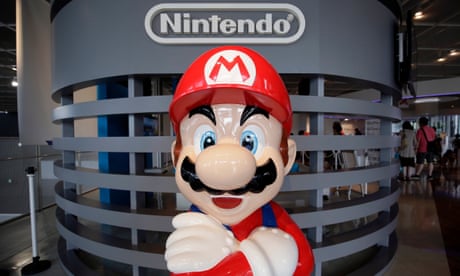- by foxnews
- 12 Mar 2025
TechScape: How Nintendo’s stayed the most innovative tech company of our time
TechScape: How Nintendo’s stayed the most innovative tech company of our time
- by theguardian
- 17 Feb 2023
- in technology

For good and for bad, the video games industry is obsessed with novelty. New consoles, new technologies and, of course, new games are what drive headlines. So it's easy to overlook one of gaming's oldest companies and underestimate the sheer scale of its success. This month, Nintendo announced its quarterly financial results and said the Nintendo Switch is now the third bestselling games console of all time with 122.5m units sold, behind Sony's PlayStation 2 (somewhere north of 155m) and Nintendo's own DS (154m). As gamesindustry.biz journalist Christopher Dring pointed out, it has beaten the DS on software sales, selling almost a billion games (994m) compared to the DS's 949m. A billion games!
For most of the 17 years that I've been covering video games, I've been reading op-eds about how Nintendo is doomed, and stuck in the past. And yet, it's still here. It doesn't follow trends, and it confounds expectations - I remember sitting in the newsroom at my first journalism job, watching my colleagues hoot with derision at the motion-controlled Nintendo Wii's reveal presentation at 2005's Tokyo game show, a console that would go on to break several sales records. Sometimes its experiments result in a flop, as with a confused follow-up to the Wii, the Wii U, in 2012 - but when that happens, instead of upending the entire company, firing executives and revamping its strategy, it simply moves on and keeps going.
What's Nintendo's secret? Aside from a willingness to fail now and then, and a commitment to keeping hardware costs down so that it makes money on every sale (as opposed to Microsoft and Sony, who lose money on Xbox and PlayStation consoles and make it back with game sales), there's an obvious answer: its games are brilliant fun, and have been since the 1980s. Its game design philosophy has been shrouded in mystery for the past few decades, but when we do get an insight into what happens inside its secretive Kyoto HQ, we see a process that prioritises fun over anything else.
"Nintendo has been great at growing and retaining talent and ensuring that continuity of game design knowhow," says Chris Kohler, author of Power-Up: How Japanese Video Games Gave the World an Extra Life. "The fact that Nintendo still makes hardware is extremely important, as they can create these great experiences to grow their own ecosystem without having to chase after the latest trends." Kohler also points to the company's gameplay-first principles: "If you look at the Splatoon 'tofu prototype', you can see that core design philosophy - they get something down that's fun to play, and then start thinking about the story, the characters, the visual design, etc. Those designs then feel much more appropriate to the gameplay because they spring up organically from gameplay, but also because nobody's trying to hack fun gameplay into a pre-existing visual design."
That fun-first design is applied equally to Nintendo's hardware and software, fuelled by a willingness to take risks; anyone who looks at 30-plus years of Mario and Zelda releases and concludes that Nintendo is not a maverick company has got things dead wrong. It has a long history of technological and creative innovation in video games, from the NES' directional pad to the Wiimote to the Nintendo 64's properly 3D worlds and movement. A few years ago it released an ingenious piece of software that turns cardboard models into playable tech toys.
At the moment, the homogenisation and consolidation of the video games industry is a big worry. Microsoft's increasingly troubled acquisition of Activision Blizzard, including leading mobile developers King, is emblematic of this, along with Chinese gaming giant Tencent, which owns stakes in more than 40 different game studios across the world, as well as its huge business at home. In the past 10 years, games have become so expensive to make that trying new things comes at a massive cost for publishers, and failures are harder and harder to absorb. The industry has stratified into ongoing games that amass user bases of millions and monetise them for years at the one end - hello Fortnite, Minecraft, World of Warcraft and Destiny - and indie games that are relatively inexpensive to create at the other. In this climate, Nintendo is a comforting presence, making games and consoles not so differently from how it always has.
The Nintendo Switch is nearing the end of its life; it was released in 2017, its sales projections are softening, Nintendo's stock is dipping as temperamental investors flit around looking for the next thing. It's got one more huge game on the horizon - The Legend of Zelda: Tears of the Kingdom, in May - and conventional wisdom would suggest that a new console is ready to be revealed before the year is out. But with Nintendo, you're never quite sure what will happen next. It marches to its own beat, rather than the market's, or a series of impulsive, ever-changing CEOs' - something that a lot of the tech industry could learn from.
Keza MacDonald is the Guardian's video games editor and writes our gaming newsletter, Pushing Buttons, every Wednesday - sign up here.
- by foxnews
- descember 09, 2016
Daring airport trend has travelers arriving at gate 15 minutes before takeoff
Flight passengers are participating in the new viral trend, "airport theory," with flyers arriving at their gates 15 minutes before their flights depart. A travel expert weighs in.
read more





